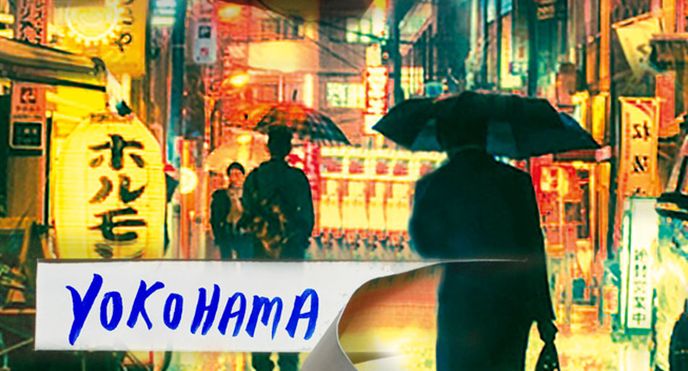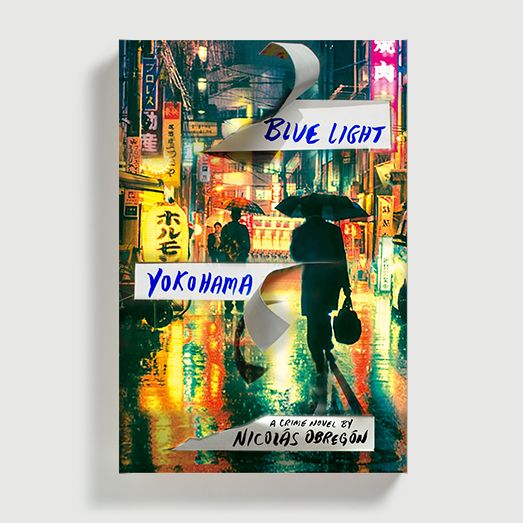
Blue Light Yokohama - Nicolás Obregón
By Nicolás Obregón
Some six years ago, I boarded a flight from London Heathrow, bound for Japan. The journey was to take half a day, starting out over fields that still held wisps of morning fog, before crossing the North Sea, then on towards Siberia. As I sat there, I could barely contain my excitement. I was in my mid-20s, working for a travel magazine, and was being sent on assignment to Japan—my dream destination.
As a stargazing kid growing up on the outskirts of Madrid, Spain, all I thought about was Captain Tsubasa, an anime show about a soccer prodigy growing up near Mount Fuji. Back then, pretty much all of the cartoons my friends watched were Japanese. The computer games we played. The comics we read. But for me, it wasn’t even the characters or the stories that fascinated me. It was the mise en scène: Strange haircuts. Raw fish. Futuristic trains. Buildings with clean angles. The way people would become embarrassed at the most trivial things. Even the alphabet looked like a secret code. Sure, these shows were translated, but it was evident that they came from a million miles away. And that’s precisely why they were wonderful to me. Each one was like a glimpse into another dimension where people looked and moved similarly but in a place so dreamily removed from mine, so completely other.
When I watched Akira, with its thrilling biker gang opening, my mouth hung open, wondering how something so marvellous could have been created by people. I gorged on video games, Streets of Rage, Golden Axe and Final Fantasy. Later came the books, In the Miso Soup, Points and Lines, and Hardboiled Wonderland and the End of the World. I had promised myself as a child that I would go to Japan one day. And now, I was keeping that promise.
Sign up for more essays, interviews and excerpts from Thought Matters.
ThoughtMatters is a partnership between Macmillan Publishers and Huffington Post
ThoughtMatters is a partnership between Macmillan Publishers and Huffington Post
By the time the plane landed, I felt like I had been cannoned into the future. In a way I had. What my body registered as night time was, for Tokyo, early morning. I passed through security where a man wearing a tie emblazoned with the word IMMIGRATION stamped my passport. I collected my rail pass, then boarded the train for Tokyo. It was then that I realised—this probably sounds stupid now—that in Japan I was essentially illiterate. The signage, the news bulletin on the screen, the train ticket in my hand, all of it was indecipherable. Now there is a stereotype about the Japanese being impenetrable, what with their never-ending customs, etiquettes, so on. But this always felt like it came from the same narrow gully of lazy thinking where you could find English gentlemen dropping everything to take tea at 5 o’ clock, or Spanish people all being big fans of bull fighting. Besides, I’d read the books, I’d played the video games, I was well-travelled and well-informed. Surely, even though I didn’t speak the language, I’d be able to blend in a little?
But as the bullet train hurtled towards Tokyo through rice paddies, greener than green, instinctively I realised I had been mistaken. I had merely brought a small collection of expectations along with me in place of knowledge. Japan had always been a sort of adopted spiritual homeland for me. But now, 6,000 miles away from London or Madrid, I realised that Japan hadn’t necessarily adopted me back. I handed my ticket to the white-gloved inspector and saw my first proper Japanese bow. Looking out at the Chiba countryside, I felt uncertain. Excited. Maybe a little alone.
By lunchtime, I’d found my hotel and dropped off my things—not even allowing myself to look at the bed, keen to avoid the notoriously bad jet-lag. Instead, I went about my work, hitting the Tokyo streets, making notes and taking photographs. Over the course of that day, I had one or two amusing culture clashes (a misunderstanding in a 7-Eleven over a sausage, asking for hair pomade in a pharmacy at which the cashier winked knowingly and placed some condoms on the counter instead). I had also fallen in love with Tokyo. But I was bone-weary.
I got back to the room around 10pm and went straight to sleep. I woke up a few hours later, completely disorientated. It took me several seconds of peering out of the window to realise: I was in Japan. I knew then there was no way I could get back to sleep, so even though the sun had not yet risen, I decided to make an early start. Outside, it was a murky blue-dark, the air chilly. I found a cafe and had my first coffee with gum syrup. I went back to the hotel and drank it in the empty lobby. It was either there or in my room that I came across an old newspaper. What I do remember with clarity is that the photograph was intriguing. I was looking at a family. A very ordinary-looking family. They were sitting on some stone steps, most likely on a day out. How could they be headline news?
Then, reading the article, I realised that this family were no longer a family, they were a cold case. A ten-year-old cold case. As the year 2000 ran into its final day, someone had broken into their home and slaughtered them all. Did they owe money? Was there some kind of affair? Or was it just a passing lunatic? The article didn’t say. What was clear, was that whoever had done it was still at large. In that empty lobby, I gazed at them for a long time and asked myself: who could murder an entire family with a sushi knife and pillow, then leave in broad daylight? The house was still there, empty. On a whim, I Googled the address. What I didn’t know, was that this throwaway little choice would change my life forever.
Taking the first train of the day, I arrived in Setagaya an hour later. It’s Tokyo’s most populous ward, a humming capillary into Shinjuku, but it also turned out be a leafy, residential area. After meandering around for some time, I came to Soshigaya Park. Finally, I found the house where the Miyazawas had lived and died. Having walked past several times, I noticed there were seven cones blocking the way and a police sign appealing for information. When the Miyazawas moved in in 1990, there had been some 200 houses here. At the time of their deaths, due to park expansion, there were only four, including theirs. Now it stood alone.
It was a handsome home, set off from the main path, framed idyllically by bushes and looming trees. Little daisies dotted the overgrown grass. In the silence, I could hear the streetlight humming. I’m not sure what sort of place one would expect an entire family to be murdered in, but for me, this was certainly not it.
The sun was up now. I tried to remember what day it was. People passed me, on their way to work, on their way to school, carrying on life. I stared at that house for a long time and asked myself: who did this?
Part 2 is up at Thought Matters’ partner site Criminal Element! Read it here: The Birth of Blue Light Yokohama: The Miyazawa Family Murders.
Part 3 is up at Criminal Element! Read it here: The Birth of Blue Light Yokohama: A Family Murder Becomes Fiction

Blue Light Yokohama - Nicolás Obregón
Nicolás Obregón is a British-Spanish dual national and grew up between London and Madrid. He has worked as a steward at sports stadiums, an editor in legal publishing and a travel writer, falling in love with Japan while on assignment for a magazine. Blue Light Yokohama is his first novel.
Read more at Thought Matters. Sign up for originals essays, interviews, and excerpts from some of the most influential minds of our age.
